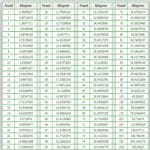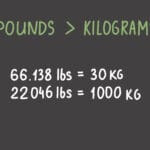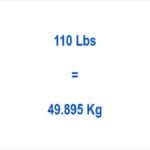This guide provides a comprehensive explanation of converting 320 kilograms (kg) to pounds (lbs), exploring the nuances of the conversion, its real-world applications, and addressing common misconceptions.
Converting 320 kg to lbs
320 kg equals approximately 705.48 lbs. For precise calculations, the value is 705.479238992 lbs. While the precise conversion is essential for scientific and engineering applications, 705.48 lbs is sufficient for most everyday purposes. Need to convert other weights? Check out our guides on converting 165kg to lbs and 192lbs to kg.
The Conversion Formula
The conversion from kilograms to pounds relies on the following formula:
Weight in pounds = Weight in kilograms * 2.20462
The factor 2.20462 is an approximation; the precise factor is 2.20462262185. This approximation, however, is perfectly suitable for most practical scenarios.
Understanding Kilograms and Pounds
Kilograms (kg) and pounds (lbs) represent different systems of measuring weight. The kilogram is the base unit of mass in the International System of Units (SI), the metric system used globally. The pound, primarily used in the US, measures both mass and force, typically referring to the avoirdupois pound used in everyday weighing.
Real-World Applications
Understanding this conversion is crucial in various real-world situations:
- International Shipping: Calculating shipping costs and complying with weight restrictions.
- Product Comparisons: Comparing the weight of products listed in different units.
- Manufacturing: Converting specifications between metric and imperial units.
- Fitness: Tracking weightlifting progress and understanding equipment specifications.
Mass vs. Weight: A Key Distinction
While often used interchangeably, mass and weight are distinct concepts. Mass represents the total amount of matter in an object, while weight measures the force of gravity acting upon that mass. On Earth, these are practically equivalent for everyday purposes, but the difference becomes significant in varying gravitational fields, such as in space.
Putting 320 kg in Perspective
320 kg is roughly the weight of a large adult male polar bear. To provide further context, consider these comparisons:
| Object/Scenario | Approximate Weight (kg) | Approximate Weight (lbs) |
|---|---|---|
| Large Male Polar Bear | ~320 | ~705 |
| Motorcycle | ~200-300 | ~440-660 |
| Grand Piano | ~250-500+ | ~550-1100+ |
| Small Car | ~800-1000 | ~1760 – 2200 |
| Adult Horse | ~450-600 | ~990 – 1320 |
How much is 1 kg in pounds?
One kilogram (kg) is approximately equal to 2.20462 pounds (lbs). This conversion is fundamental for various everyday applications, from interpreting recipe ingredients to estimating luggage weight. While 2.2 lbs is a commonly used approximation, the more precise figure is essential for applications requiring accuracy. Understanding this conversion aids in numerous scenarios, such as converting weights listed in different units or interpreting international product labels.
The Kilogram and the Pound: Defining the Units
The kilogram (kg) is the base unit of mass in the SI system, initially defined by the mass of one liter of water and now based on the Planck constant. The pound (lb), used in imperial and US customary systems, often denotes weight, the force of gravity on an object. This distinction between mass and weight, while subtle on Earth, becomes crucial in scenarios with varying gravitational forces.
Performing the Conversion
Converting kilograms to pounds involves multiplying the kilogram value by 2.20462. Conversely, dividing pounds by the same factor yields the equivalent in kilograms. This simple calculation is akin to translating between languages, expressing the same quantity using different units.
| Kilograms (kg) | Pounds (lbs) (approximate) | Pounds (lbs) (precise) |
|---|---|---|
| 1 | 2.2 | 2.20462 |
| 5 | 11 | 11.0231 |
| 10 | 22 | 22.0462 |
| 25 | 55 | 55.1155 |
| 50 | 110 | 110.231 |
The Importance of Precision
While the approximation of 2.2 lbs is suitable for everyday estimations, precision becomes critical in scientific research, engineering, and manufacturing, where even minor discrepancies can have substantial consequences. Understanding the context dictates the necessary level of accuracy, highlighting the importance of recognizing the appropriate conversion factor for specific situations.
How much is 400 kg in weight?
400 kg is equivalent to approximately 881.85 lbs, a substantial weight comparable to several large refrigerators. This conversion is frequently utilized in various scenarios, including shipping calculations and fitness tracking.
The Conversion Process
The conversion relies on the factor 2.20462, representing the approximate equivalence of 1 kg to pounds. Multiplying 400 kg by this factor yields the approximate weight in pounds. For the reverse conversion, dividing the weight in pounds by the same factor provides the equivalent in kilograms. Online conversion tools offer a quick and convenient method for these calculations.
Practical Applications
Understanding this conversion has practical implications in various fields:
- International Shipping: Determining shipping costs and adherence to weight limitations.
- Fitness: Monitoring weightlifting progress and assessing equipment weights.
- Engineering and Construction: Calculating material loads and ensuring structural integrity.
Precision and Refinement
While 881.85 lbs is a sufficiently accurate conversion for most purposes, situations demanding greater precision might require expressing the weight in ounces, resulting in approximately 881 pounds and 13.6 ounces. This highlights the importance of considering the required level of precision for specific applications.
Mass and Weight: A Subtle Distinction
It’s essential to differentiate between mass and weight. Mass quantifies the amount of matter in an object, while weight measures the gravitational force acting upon that mass. While practically interchangeable on Earth, this distinction becomes crucial in environments with varying gravitational forces, such as in space.
Ongoing Research and Future Understandings
Current scientific understanding suggests a fixed relationship between kilograms and pounds. However, ongoing research in metrology, the science of measurement, continually refines our understanding of these concepts and the precision of the conversion. While we can rely on current conversions, future discoveries may further enhance our understanding of mass and weight.
Is 1 kg equal to 2 lbs?
While the approximation of 1 kg equaling 2 lbs is often used for quick estimations, it’s crucial to remember that the precise conversion is 1 kg to 2.20462 lbs. While seemingly insignificant, this difference can become substantial when dealing with larger weights, potentially leading to inaccuracies and unforeseen complications.
The Importance of Precision
The seemingly small difference between 2 lbs and 2.20462 lbs becomes increasingly significant with larger weights. This underscores the importance of using the precise conversion, especially in professional contexts where accuracy is paramount. Using the correct conversion factor avoids accumulating errors and ensures reliable results.
Performing the Conversion
Converting kg to lbs involves multiplying the kilogram value by 2.20462, while the reverse conversion involves dividing the pounds by the same factor. This straightforward calculation is crucial for maintaining accuracy and avoiding potential discrepancies.
| Kilograms (kg) | Pounds (lbs) |
|---|---|
| 1 | 2.20 |
| 5 | 11.02 |
| 10 | 22.05 |
| 50 | 110.23 |
| 100 | 220.46 |
| 320 | 705.48 |
Real-World Implications
Accurate weight conversions are essential in various fields:
- Medicine: Calculating precise drug dosages.
- Engineering: Designing structures requiring precise weight considerations.
- International Shipping: Avoiding unexpected fees and delays due to inaccurate weight declarations.
- Personal Fitness: Accurately tracking weight and progress towards fitness goals.
The Origins of the Approximation
The simplified conversion of 1 kg to 2 lbs likely originated as a rule of thumb for quick estimations in casual conversations. However, when precision is required, using the exact conversion factor is essential to avoid potential errors and ensure accuracy.
- Crypto Quotes’ Red Flags: Avoid Costly Mistakes - June 30, 2025
- Unlock Inspirational Crypto Quotes: Future Predictions - June 30, 2025
- Famous Bitcoin Quotes: A Deep Dive into Crypto’s History - June 30, 2025
















1 thought on “How Much is 320 kg in Pounds? A Definitive Guide”
Comments are closed.